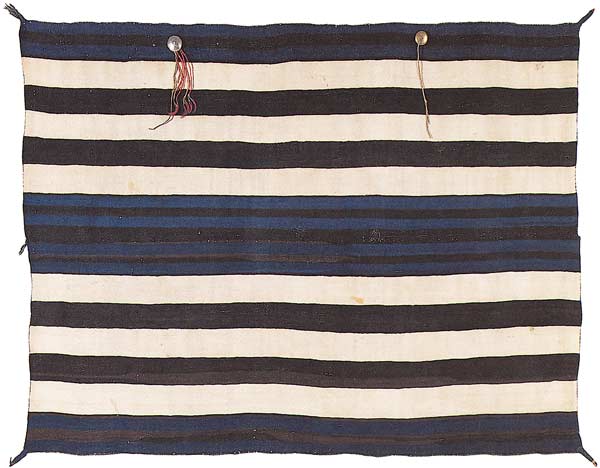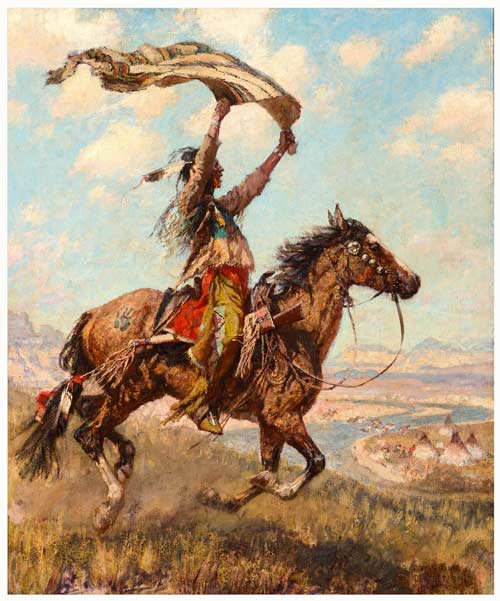#10. A Classic First Phase Chief’s Blanket, Ute Style, Navajo, circa 1850, also known as the De Cost Smith First Phase. The first phase measures 55 inches long by 72 inches wide, as woven.
De Cost Smith (1864-1939) was an American painter. He grew up south of Syracuse, New York, near the Onondaga Reservation. Smith was an initiated member of the Onondaga Tribe. He purchased the first phase in South Dakota, in 1930, from
a member of the Brulé Sioux tribe. The first phase was in original condition when
Smith purchased it.
De Cost Smith (1864-1939) was an American painter. He grew up south of Syracuse, New York, near the Onondaga Reservation. Smith was an initiated member of the Onondaga Tribe. He purchased the first phase in South Dakota, in 1930, from a member of the Brulé Sioux tribe. The first phase was in original condition when Smith purchased it.
The first phase’s original braided corner tassels, side selvages, and top and bottom edge cords show no signs of wear. The fact that Smith purchased the first phase from a member of the Brulé Sioux tribe means the first phase was protected—as opposed to being worn as a garment—from the time it was woven and then either sold or bartered to its original Brulé Sioux owner.
In 1939, following De Cost Smith’s death, the first phase was donated by Smith’s estate to the Museum of the American Indian / Heye Foundation, in New York.
In 1989, the collection of the Museum of the American Indian was transferred to the Smithsonian Institution, in Washington, DC, and became what is now the collection
of the National Museum of the American Indian. [NMAI#20.1339.]
In 1939, following De Cost Smith’s death, the first phase was donated by Smith’s estate to the Museum of the American Indian / Heye Foundation, in New York. In 1989, the collection of the Museum of the American Indian was transferred to the Smithsonian Institution, in Washington, DC, and became what is now the collection of the National Museum of the American Indian. [NMAI#20.1339.]


Above: The De Cost Smith First Phase, Ute Style, Navajo, circa 1850.
The first phase measures 55 inches long by 72 inches wide, as woven.
Below: The Woodhouse Bayeta First Phase, Navajo, circa 1850.
The first phase measures 51 inches long inches by 71 inches wide, as woven.
The De Cost Smith First Phase follows the traditional Ute Style format of two brown bands and three white bands above and below its brown central panel, with four pairs of blue stripes in its central, lower, and upper brown panels. With two exceptions, this format is common to all of the classic Ute Style first phases woven in the man’s style prior to 1865.
The Woodhouse Bayeta First Phase’s thin red stripes qualify it as a bayeta style first phase. While Ute Style first phases were the earlier style, it would be a mistake to assume that all classic bayeta first phases were woven later than classic Ute Style
first phases. Between 1840 and 1860, the two styles were being woven simultaneously. There are less than eighty classic Navajo first phase chief’s blankets woven in the man’s style in museum and private collections. Less than sixty-five are Ute Style classic
first phases. Less than fifteen are classic bayeta style first phases.
The Woodhouse Bayeta First Phase’s thin red stripes qualify it as a bayeta style first phase. While Ute Style first phases were the earlier style, it would be a mistake to assume that all classic bayeta first phases were woven later than classic Ute Style first phases. Between 1840 and 1860, the two styles were being woven simultaneously. There are less than eighty classic Navajo first phase chief’s blankets woven in the man’s style in museum and private collections. Less than sixty-five are Ute Style classic first phases. Less than fifteen are classic bayeta style first phases.
In 1996, the De Cost Smith First Phase was exhibited as part of Woven By The Grandmothers, an exhibition of classic and late classic Navajo blankets, at the National Museum of the American Indian at Bowling Green, New York. The De Cost Smith First Phase is illustrated as Plate 21 in Bonar, Woven By The Grandmothers, the exhibition catalog. Bonar classifies the first phase as a Beeldléi, and dates it “1840-50.” Beeldléi
is a Navajo word for “blanket.”
In 1996, the De Cost Smith First Phase was exhibited as part of Woven By The Grandmothers, an exhibition of classic and late classic Navajo blankets, at the National Museum of the American Indian at Bowling Green, New York. The De Cost Smith First Phase is illustrated as Plate 21 in Bonar, Woven By The Grandmothers, the exhibition catalog. Bonar classifies the first phase as a Beeldléi, and dates it “1840-50.” Beeldléi is a Navajo word for “blanket.”
On Page 177 of Woven by the Grandmothers, under Notes On Selected Collectors, Bonar describes De Cost Smith as: “a painter of western scenes…” who “… grew up near the Onondaga Indian Reservation and was initiated into the Onondaga Tribe.”

Between 1800 and 1850, Navajo first phases became popular trade items between Navajo weavers and high-ranking members—or chiefs—of the Arapahoe, Blackfoot, Cheyenne, Brulé Sioux, Lakota, Kiowa, Shoshoni, and Ute tribes. The chiefs of these tribes would pay as much as fifty buffalo hides, twenty horses, ten rifles, or five ounces of gold for one first phase, and then either wear the first phase or give it to one of their wives or daughters to wear as a prestige garment.
During the first half of the nineteenth century, throughout the Great Plains and the Prairies, travel was either on foot or on horseback. When you saw a group of people approaching your camp or your village, you saw them from a distance before you met them face-to-face. If one of the people approaching your camp was wearing a first phase, especially if he was on horseback, the contrast between the first phase’s brown and white bands told you something about that person long before you met him.
The first phase told you one of the people approaching your camp could afford to own a chief’s blanket. More often than not, this meant that individual was a high-ranking member of his tribe.
During the first half of the nineteenth century, throughout the Great Plains and the Prairies, travel was either on foot or on horseback. When you saw a group of people approaching your camp or your village, you saw them from a distance before you met them face-to-face. If one of the people approaching your camp was wearing a first phase, especially if he was on horseback, the contrast between the first phase’s brown and white bands told you something about that person long before you met him. The first phase told you one of the people approaching your camp could afford to own a chief’s blanket. More often than not, this meant that individual was a high-ranking member of his tribe.

A drawing of Iroquois medicine masks and a turtle rattle by DeCost Smith (1864-1939).

The Signal, 1905, by De Cost Smith (1864-1939). Oil on canvas.
The painting measures 36 inches long by 30 inches wide.
In the painting, a Plains warrior holds a Navajo blanket above his head, as a signal to the other members of his war party. The blanket appears to be a first phase with bold red stripes, but the striping pattern does not look classic.

In the De Cost Smith First Phase, the blue yarns are handspun Churro fleece dyed in the yarn with indigo. The brown yarns and the white yarns are both un-dyed handspun Churro fleece.
The two discs sewn onto the top band are German Silver—a white alloy of copper, zinc, and nickel. German silver contains no traces of silver. During the nineteenth century, German Silver was a trade item between the Plains tribes and Anglo-American traders. The terms “German silver” and “Nickel silver” were used interchangeably. Quill-wrapped horsehair tassels are suspended from the German Silver discs. The discs and their quill-wrapped tassels show how a member of the Brule Sioux tribe personalized the first phase.
The immaculate condition of the De Cost Smith First Phase—it retains 100% its original braided corner tassels, side selvages, and top and bottom edge cords—confirms that its Brule Sioux owners treated it as a heirloom. Given De Cost Smith’s familiarity with Native American cultures, Smith’s decision to acquire the first phase and then protect its original condition can be seen as a continuation of the care
and respect shown to the first phase by its original Brule Sioux owners.
The immaculate condition of the De Cost Smith First Phase—it retains 100% its original braided corner tassels, side selvages, and top and bottom edge cords—confirms that its Brule Sioux owners treated it as a heirloom. Given De Cost Smith’s familiarity with Native American cultures, Smith’s decision to acquire the first phase and then protect its original condition can be seen as a continuation of the care and respect shown to the first phase by its original Brule Sioux owners.



